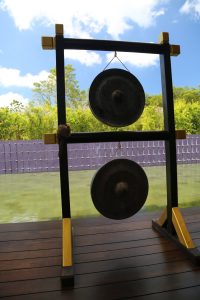 President Susie Ellis Predicts “Aging-Raging,” An Explosion of Spa Brands, A Liberal Dose of Salt, and Dubs 2011 ‘The Year of Asia’
President Susie Ellis Predicts “Aging-Raging,” An Explosion of Spa Brands, A Liberal Dose of Salt, and Dubs 2011 ‘The Year of Asia’
Click here for a detailed version of SpaFinder’s 2011 Spa Trend Report.
NEW YORK, NY – December 22, 2010 – SpaFinder, Inc., the global spa and wellness resource, today announced its annual spa trend forecast, now in its eighth year. SpaFinder’s Spa Trend Report identifies global spa trends that will influence spa experiences for both consumers and the industry in the coming year and for decades to come.
The report is based on analyses from a large team of experts who visit hundreds of day and stay spas each year; interviews with top industry analysts; ongoing research across the spa, travel and beauty sectors; and data derived from SpaFinder’s relationships with over 9,000 spas and salons across the globe.
The Spa Trend Report is developed under the direction of SpaFinder President Susie Ellis, who is also the author of an influential blog and column and a contributing editor to NewBeauty magazine. Ellis is credited for being the first to forecast numerous industry ‘mega-trends’ that have taken hold in spas around the world.
‘As someone who’s watched the modern spa industry from its infancy, I have never seen the aggregate level of creativity and talent in the field, as wellness, fitness, beauty, design and cuisine are blended in unique new ways, just as the economy begins its upswing, Ellis says.
2011 SPA TREND REPORT
1. The Pain Relief Massage
Relaxation – that’s been the number one reason people go to spas for over 25 years. With the oldest baby boomer reaching retirement age in 2011, look for relaxation to soon be replaced by pain relief.
Baby boomers are the fastest-growing demographic in the world. As millions of Boomers (which galvanized the spa/wellness revolution) are now turning 65 each year, spas will begin to incorporate exercise physiologists, chiropractors, orthopedics and naturopaths focusing on rejuvenation of joints, pain relief and mobility. Pain relief massages, ‘corrective facials,’ and ‘everything anti-aging’ are increasingly found on spa menus.
2. Salt Rooms and Inhalation Salt Therapy
Healing traditions involving basking in salt caves are coming of age in some of the most modern spas. The benefits to skin, breathing, and rejuvenation are making inhalation salt therapy — or halotherapy — one of the hottest trends to watch in 2011.
Spas are finding stylish new ways to recreate the natural salt cave microclimate, infusing salt and negative ions into the air. Some examples have encrusted, stalactite-drenched grottoes (comprised of tons of imported Himalayan salt crystals). And with decreased need of a therapist’s involvement, the treatments are attractive to spas from a cost side. Bottom line is that salty is sweet for spas and consumers in the coming year.
3. Sample, Express, Mini-sized, and Simultaneous Treatments
We inhabit a stressed-out, 24/7 world, and the spa industry is responding, helping people spa anytime and offering ‘sample’ ‘express’ mini-sized’ and simultaneous treatments.
While ‘In a New York minute’ is jargon for how things move faster in hectic New York City, it’s also the name of a suite of mini (15- to 30-minute) spa treatments (performed simultaneously by multiple therapists) at the new Auriga Spa at The Setai Fifth Avenue NYC.
Equally a nod to the ‘New York Minute’ is the move toward simpler spa menus and a decline in elaborate rituals at many spas, to get right to the heart of the matter: the therapeutic treatment.
A 9 p.m. closing time is the new spa norm, and ‘open late’ means 2:00 am. The explosion of airport spas worldwide plays into the ‘express’ trend neatly. The quest for efficiencies is also reflected in new facility design directions, with locker rooms on the decline and even check-in counters being rethought, and 24/7 online appointment booking, and mobile apps helping people find and book spas on the fly.
4. Farm-to-Massage Table and Farm-to-Spa Cuisine
Spas have been moving away from the generic ‘could be anywhere’ vibe for years, meeting spa-goers intensifying desire for authenticity and immersion in treatments, food, design and experiences indigenous to the spa’s unique place and culture. A maple scrub in Canada, organic food from the spa garden, or facilities built of local stone, while not new, were, until relatively recently, novelties.
But spas are now going hyper-local, putting unique twists on the ‘farm-to-table’ movement, with farm-to-spa cuisine and farm-to-massage-table treatments. Hyper-local also means ramped-up community/philanthropic projects; 100% locally sourced building materials; mandating local hiring policies; and finding creative new ways to connect people more deeply with place and nature. Guests are gardening, farming, preparing their own food, and making expeditions to local artisans and schools.
5. Demand for Scientific Proof Behind Spa Treatments
Is there scientific proof that massage reduces stress? Are mineral-baths medically proven to alleviate pain? Is ear candling proven to remove earwax? The answers: yes, yes and no. Get ready for a new era where more questions about the effectiveness of spa therapies and products will be asked, and where questions will get answered more transparently, as the emphasis on evidence-based medicine and the ‘science behind spa’ heats up.
A recent example: The New York Times reported on a major US medical study revealing that a 45-minute massage resulted in a significant decrease in stress hormones, while boosting immunity.
6. Extreme’and Painful Beauty Treatments
The common element in spa beauty these days is beauty-seekers taking it to the max. We are far beyond Botox; stem-cell facials, plasma therapy (where blood is drawn and re-injected) and Ultherapy (no surgery, using ultrasound to regenerate collagen under the skin) are the new buzzwords.
There is also extreme pain, something people seem to be tolerating more and more, as long as it delivers the goods. Derma-rolling hurts, chemical peels can be uncomfortable and the zapping of lasers is no picnic. And facials aren’t just for faces anymore; now they are being applied to every extremity, including ‘booty’ and ‘vagina’ facials.
Extremes like military-style boot camps, Rolfing and Bikram yoga, where pain meets pleasure are on the rise also. Even organic and natural products boundaries are being pushed, with raw food cuisine gaining popularity during intense detox retreats.
What everyone can agree upon? They want extreme results.
7. The Asia Spa Boom
Asia’s impact on the spa industry is profound: Yoga, Thai massage, Ayurvedic medicine and acupuncture are staples on global spa menus, and the ‘Zen’ nature of Asian design is felt in spas worldwide.
But if, historically, it’s been a tale of the mass exportation of Asian spa influences, a powerful new story is unfolding: The explosive growth of hotel/spa development within Asia (a market of 4.1 billion people), especially within the two fastest-growing world economies, China and India, where extraordinary new class mobility is being unleashed. Asia-Pacific has the largest number of spas and hotels under development of any region in the world, and by 2015, China will have 100 million outbound travelers, many seeking a luxury lifestyle, including the ‘western’ spa experience.
8. Unique Group and Learning Experiences
Increasingly, spas are developing distinctive specialty programs to draw patrons seeking something more – a unique group or learning experience. While destination spas have been doing yoga and healthy cooking weeks for years, retreats now span everything from a high-flying ‘Trapeze Experience’ to creative jewelry-making to the more sober and grounded gathering for survivors of loss.
Celebrity authors and artists now headline these programmed stays, like the recent ‘Dine and Dive Week’ in the Maldives headed up by Jacque Cousteau’s son Fabien. We expect this trend to flourish in the coming year, as spas and resort destinations find creative new ways to prove that unique is indeed chic for the savvy consumer.
9. Spa Brands Go Global
Traditionally the province of standalone spas, the industry is moving rapidly in the direction of branded experiences. 2011 will be a watershed year for franchised/branded spas, as consumers seek the consistency of treatments they know and love, and major players expand into new markets.
A stratified market offers choice: From the cool, urban Bliss or Exhale to the eco-luxury of Six Senses; from, the lavish opulence of Mandarin Oriental to Mandara’s more affordable Chevana brand, or the low cost options such as Massage Envy, look to see a brand new world of spa lines going global.
10. Spas Embrace Deals and Coupons
Gone are the days when coupons were unfashionable things people snipped out of newspapers and spas wouldn’t think of using the term “deal.” Put an “e-” or “group” in front of “coupon,” and you suddenly have the hottest Internet mania of 2010, poised to accelerate at an even more dizzying pace in 2011.
Online group-buying deals have burst onto the global scene, and the old-fashioned deal has morphed into a hip online industry. And with spa/wellness deals a mainstay of generic deal sites like GroupOn or LivingSocial, it’s a sure sign that spa-going has achieved mainstream traction.
With so many spa deals being blasted into inboxes, millions of people are now expanding their spa horizons, trying new spa experiences they wouldn’t have without the 50%-75% off.
About SpaFinder, Inc.
The world’s largest spa media, marketing, and gifting company, SpaFinder, Inc., connects millions of wellness-focused consumers with thousands of spas worldwide. SpaFinder’s media properties include the award-winning SpaFinder.com, the Club Spa e-newsletter and blog, and the annual NewBeauty SpaFinder Guide to Global Spa, Wellness & Beauty. SpaFinder and its spa-beauty gift division, SpaWish, offer gift certificates and cards that are redeemable at a combined network of over 9,000 spas and salons, and are available at more than 90,000 unique retail outlets in 79 countries. SpaFinder Europe and SpaFinder Japan offer regional spa marketing and gifting programs, including localized, native-language websites. Founded in 1986, the privately held company is headquartered in Manhattan.
About Dave's Travel Corner
 Dave's Travel Corner is a travel content, resource provider and community (founded 1996) providing travel Guides written about Dave's personal travel experiences and Journals, pages that contain trip summaries and experiences written by fellow travelers. We spotlight locations and attractions with an article linked directly from our homepage including content across our blog, photo and video galleries. We use a combination of social media, written content, photography and videos to promote locations. Not only does the content appear on this site but we have direct partnerships with other well visited travel sites for placement of the content. Since 1996, we have also established hundreds of relevant link exchanges with other travel sites.
Dave's Travel Corner is a travel content, resource provider and community (founded 1996) providing travel Guides written about Dave's personal travel experiences and Journals, pages that contain trip summaries and experiences written by fellow travelers. We spotlight locations and attractions with an article linked directly from our homepage including content across our blog, photo and video galleries. We use a combination of social media, written content, photography and videos to promote locations. Not only does the content appear on this site but we have direct partnerships with other well visited travel sites for placement of the content. Since 1996, we have also established hundreds of relevant link exchanges with other travel sites.
Visitors to Dave's Travel Corner will also find thousands of travel related links organized by categories on the Resources Page, a Photo Gallery containing International travel photos, Book Reviews, and Product Reviews focusing on products useful for travelers, fully automated Forums, Tour Bookings offering over 4400 unique tours around the globe, Interviews with those making news in the travel industry and Videos - specializing in International travel videos as well as home of the Dave & Jim Show.
Dave's own travel blog is Above the Clouds which focuses on International Travel & Lifestyle.
For information on advertising please choose from a variety of advertising options here.
Contributors are welcome





Leave a Reply